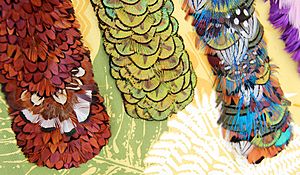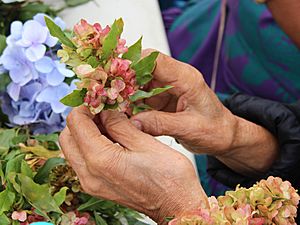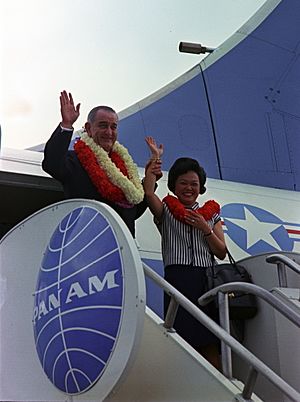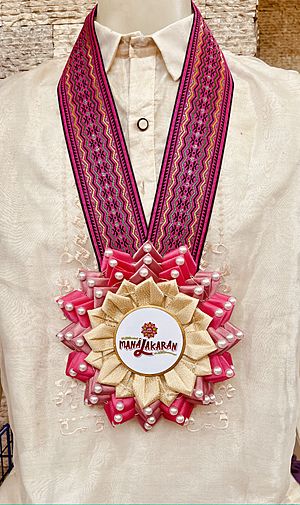Lei (garland) facts for kids
A lei (pronounced "lay") is a special garland or wreath. It is very common in Hawaii, across Polynesia, and in the Philippines. Simply put, a lei is any group of objects strung together to be worn. People give leis as gifts to honor others throughout the Pacific. For example, they are given to important visitors, graduates, or loved ones who are leaving.
Leis became well-known in the United States because tourists in Hawaii often received them when arriving or leaving. In the Philippines, sampaguita leis are also used for religious reasons. People typically wear them when honoring their Anito (religious statues).
Contents
What Leis Mean
People give leis for many reasons. Most often, they represent peace, love, honor, or friendship. Leis are commonly given during events like graduations, weddings, and school dances. Sometimes, what a lei is made of shows its special meaning. For example, a lei made from a hala fruit is linked to love, desire, new beginnings, and change.
What Leis Are Made Of
A lei can be made from almost anything strung together in a pattern. However, most leis are made from fresh natural things. These include flowers, leaves, vines, fern fronds, and seeds. Popular flowers for leis are plumerias, tuberose, carnations, orchids, and pikake. Maile leaves, ferns, and tī leaves are also very popular and traditional for hula dancers.
Other types of leis can be made from:
- Sea or land shells
- Fish teeth or bones
- Feathers
- Plastic flowers or fabric
- Paper (like origami or money bills)
- Candy
Anything that can be strung together and worn as a wreath or necklace can become a lei. The Hawaiian island of Niʻihau is famous for its leis. These are made from tiny, gem-like shells called pūpū.
How Leis Are Made
There are eight main ways to make a lei:
- Haku: This method involves braiding a base material, like soft tree bark or long leaves. As you braid, you add decorative plants into each wrap. This is often used for flowers and leaves with long, flexible stems.
- Hili: This is a simple braid or plait using only one type of material. It's usually made from three or more strands of flexible vine or fern braided together.
- Hilo: This method means to twist or intertwine. You twist two strands together to form a "rope." The popular and simple lei lāʻī (tī leaf lei) is made this way.
- Hipuʻu / nipuʻu: In this method, you knot the stems of the decorative plants. Then, you string the next stem through the knot. This needs very long stems on the plants. It's similar to making a daisy chain.
- Humu / humuhumu: This means to sew to a backing. You sew the decorative material onto a base like hala leaves, laʻi leaves, paper, or felt. Each new row of lei material overlaps the one before it. This creates a look like scales. Bougainvillea leis and feather hat leis are often made this way.
- Kui: This method means to pierce or stitch. You sew or pierce the decorative material with a needle. Then, you string it onto a thread. This is probably the way most people outside Hawaii imagine leis are made. It's commonly used for flowers like plumeria, rose, and carnation.
- Wili: This means to wind, twist, or coil. It creates a corkscrew-like twist. You wind a fiber around short lengths of the decorative material. Sometimes, base materials like hala or laʻi strands are used to make wrapping easier.
- Haku mele: This is different from the others. It means "to braid a song." A song written out of love for someone is also considered a lei.
Leis can be open (not connected at the ends) or closed (a full circle), depending on the situation. These leis are usually made using natural plants.
History of Leis
Leis were first worn by ancient Polynesians and some Asian people as part of their traditions. In ancient Hawaii, leis often showed a person's rank or royal status. They were also worn to show honor to each other and to their gods. The religion and hula dance traditions of Native Hawaiians are closely linked to the leis they wore.
Native Hawaiians, who are Polynesian, brought the custom of making and wearing leis with them when they arrived in the Hawaiian islands. Every year on May 1st, people celebrate "Lei Day." This event honors the art of lei making and the traditions around it.
Lei Customs and Traditions
There are many customs about giving, receiving, wearing, storing, and getting rid of leis. A story from World War II tells of a hula dancer who gave a lei and a kiss to a US soldier. This helped make giving leis a common tradition today. Leis are still a very important part of Hawaiian culture.
People traditionally give a lei by bowing slightly and holding it above their heart. The person receiving it then takes it. Raising hands above someone's head or touching their face or head is considered disrespectful.
By tradition, only open leis are given to pregnant or nursing women. If someone cannot wear a lei they just received (for example, a musician whose lei would get tangled in their guitar strap), the lei is placed in a special spot. This might be on the musician's music stand or microphone stand.
Leis should never be thrown away carelessly or put in the trash. Traditionally, they should be returned to where their materials were gathered. If that is not possible, they should be returned to the earth. This can be done by hanging them in a tree, burying them, or burning them. A lei stands for love, and throwing it away means throwing away the love of the giver. Many leis can be left in a window to dry. This lets their natural smell fill the room. This is also often done in cars.
Leis in Polynesia
In Polynesian cultures, a lei is something someone makes and gives to another person. It is meant to decorate that person for an emotional reason, usually as a sign of affection. Common reasons include greeting, saying goodbye, showing love or friendship, appreciation, congratulations, or to simply notice the person.
- In Samoa, similar garlands made of flowers, buds, seeds, nuts, leaves, or shells are called "asoa" or "ula." Single flowers worn in the hair are called sei.
- In Tahiti, these garlands are called "hei."
- In the Cook Islands, they are called an "ei."
Tongans are known for making unique "kahoa" leis. These are chains of flat, crescent, or triangle shapes made from flower petals and leaves sewn onto a backing. In Niue, the special lei is the kahoa hihi. It is made from strings of tiny, yellow snail shells.
Many modern Polynesian celebrations include giving and receiving leis. These can be traditional flower leis or newer versions. These new leis might use candy, folded money bills, rolls of coins, or even spam musubi (a popular snack). "Non-traditional" materials like cloth ribbon, sequins, and yarn are also often used to make leis today.
Leis in Hawaiʻi
In Hawaiʻi, leis are very popular for birthdays, graduations, weddings, funerals, retirement parties, and bridal showers. It is common to see a high school or college graduate wearing so many leis that they reach their ears or even higher!
Every year on May 1st, Hawaiians celebrate "Lei Day." Poet Don Blanding first thought of this idea in 1927. He worked for the Honolulu Star Bulletin newspaper. He shared his idea with writer Grace Tower Warren, who came up with the saying, "May Day is Lei Day." The Hawaiian song, "May Day is Lei Day in Hawaii," was written in 1927 by Ruth and Leonard "Red" Hawk.
At the 81st Annual Mayor's Lei Day Celebration in 2008, Honolulu set a record. They made the World's Longest Lei. It was unofficially measured at over 5,336 feet long, which is more than a mile!
All the main Hawaiian islands celebrate Lei Day. Each island is represented by a special type of lei and a color:
- Hawaiʻi: red, ʻōhiʻa lehua (a type of flower)
- Maui: pink, lokelani (a type of rose)
- Kahoʻolawe: gray or silver, hinahina (a plant)
- Lānaʻi: orange, kaunaʻoa (a vine)
- Oʻahu: yellow or gold, ʻilima (a flower)
- Molokaʻi: green, kukui (a nut tree)
- Kauaʻi: purple, mokihana (a berry)
- Niʻihau: white, pūpū o Niʻihau (Niʻihau shells)
Leis in the Philippines
In the Philippines, it was an old custom to welcome guests by giving them a flower necklace made of sampaguita. This is the country's national flower. However, in recent years, more affordable options have become popular. This is because fresh flowers are hard to keep fresh, especially during long events. One popular modern option is rosette leis. These are made from Brocade fabric cut into different designs. They often have a centerpiece flower made of satin ribbon.
Images for kids
-
Prince Alexander Liholiho wearing a lei garland
-
Queen Emma is wearing multiple strands of lei pūpū o Niʻihau
-
Young hula dancers wearing kukui nut lei.
-
Lei of plumeria flowers and 'umi'umi-o-dole (Spanish moss) on an outrigger canoe.
-
Leis for sale in the Cook Islands.
-
New Zealand Governor General and members of the Cook Islands cabinet wear lei at a meeting.
-
Prime Minister of New Zealand Jacinda Ardern and Pasifika Members of Parliament wear lei at an event.
-
A giant-lantern inspired rosette leis in pink and gold. Given to Former Vice President Maria Leonor Robredo.
See also
 In Spanish: Lei hawaiano para niños
In Spanish: Lei hawaiano para niños



















